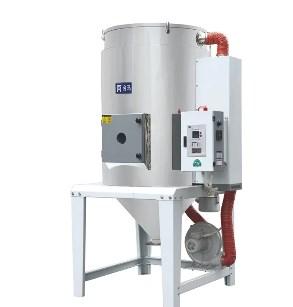The PET Hopper Dryer, a crucial component in the plastics industry, plays a pivotal role in the processing of polyethylene terephthalate (PET) materials. This article aims to explore the significance of PET Hopper Dryers in enhancing the efficiency, quality, and sustainability of plastic production processes.
Polyethylene terephthalate, commonly known as PET, is a widely used thermoplastic polymer that is renowned for its versatility, strength, and clarity. It is extensively utilized in the manufacturing of bottles, containers, films, and fibers. However, the presence of moisture in PET materials can significantly affect the quality of the final product, leading to issues such as warping, dimensional instability, and poor mechanical properties. This is where the PET Hopper Dryer comes into play.
A PET Hopper Dryer is a specialized piece of equipment designed to remove moisture from PET materials before they are processed. It typically consists of a hopper, which holds the PET material, and a drying system that uses heat and airflow to evaporate the moisture. The hopper is designed to ensure a consistent and uniform flow of material into the drying chamber, which is essential for achieving optimal drying results.
The use of PET Hopper Dryers has several benefits for the plastics industry. Firstly, it improves the quality of the final product by eliminating the negative effects of moisture on the PET material. This results in a more consistent and uniform product with better mechanical properties, such as tensile strength and impact resistance. Secondly, it enhances the efficiency of the production process by reducing the time and energy required to process the PET material. This is achieved by ensuring that the material is dry and ready for processing, reducing the need for additional drying steps.
Moreover, PET Hopper Dryers contribute to the sustainability of the plastics industry by reducing waste and energy consumption. By removing moisture from the PET material, the dryers help to minimize the occurrence of defects and reject, which would otherwise be discarded as waste. Additionally, the efficient drying process reduces the energy required for processing, leading to lower energy consumption and a smaller carbon footprint.
The performance of a PET Hopper Dryer is influenced by several factors, including the type of PET material, the moisture content, and the drying temperature. To achieve the best results, it is essential to select the appropriate dryer for the specific application and to optimize the operating conditions. This may involve adjusting the temperature, airflow, and material feed rate to ensure that the PET material is dried effectively and efficiently.
In conclusion, PET Hopper Dryers play a vital role in the plastics industry by improving the quality, efficiency, and sustainability of PET material processing. By removing moisture from the material, these dryers help to produce high-quality products with better mechanical properties and reduced waste. Furthermore, they contribute to the overall sustainability of the industry by reducing energy consumption and minimizing the environmental impact. As the demand for PET materials continues to grow, the use of PET Hopper Dryers will remain an essential aspect of the plastics production process.
